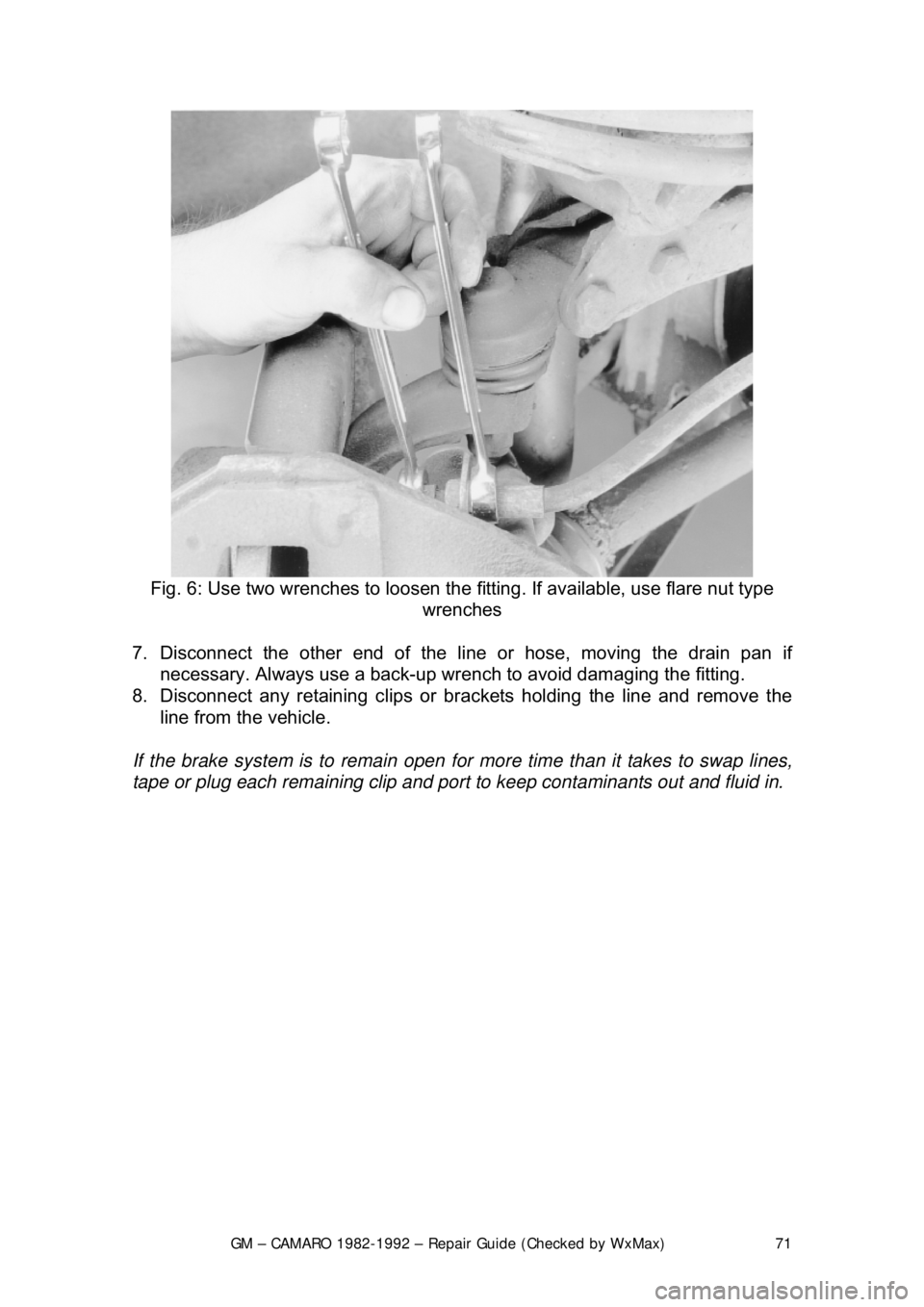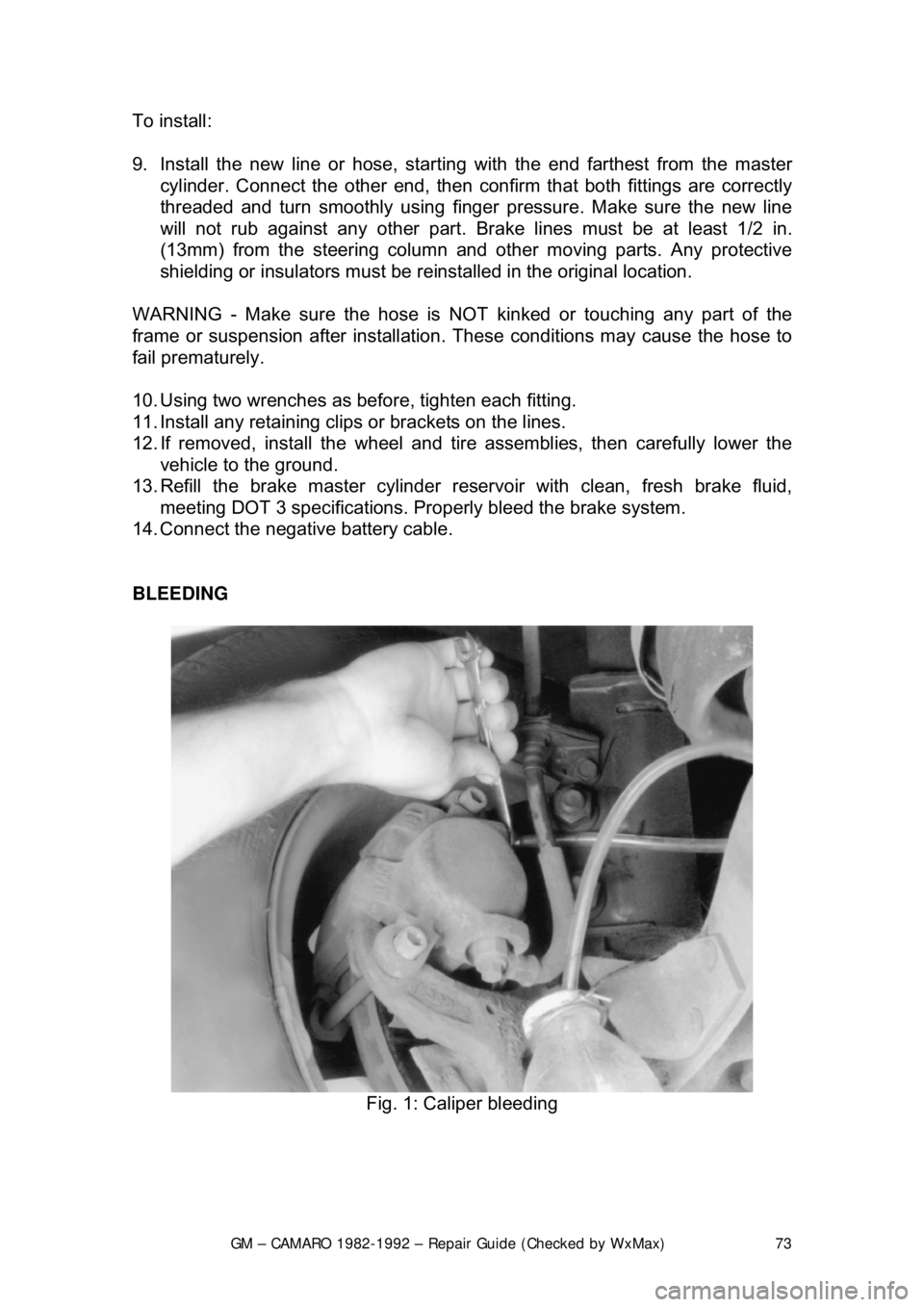1982 CHEVROLET CAMARO brake fluid
[x] Cancel search: brake fluidPage 48 of 875

GM – CAMARO 1982-1992 – Repair Guide (Checked by WxMax) 48
BRAKES
BASIC OPERATING PRINCIPLES
Hydraulic systems are used to actuate t he brakes of all modern automobiles.
The system transports the power required to force the frictional surfaces of the
braking system together from the pedal to the individual brake units at each
wheel. A hydraulic system is used for two reasons.
First, fluid under pressure can be carried to all parts of an automobile by small
pipes and flexible hoses without taking up a significant amount of room or
posing routing problems.
Second, a great mechanical advantage can be given to the brake pedal end of
the system, and the foot pressure requi red to actuate the brakes can be
reduced by making the surface area of t he master cylinder pistons smaller than
that of any of the pistons in t he wheel cylinders or calipers.
The master cylinder consists of a flui d reservoir along with a double cylinder
and piston assembly. Double type master cylinders are designed to separate
the front and rear braking systems hydraulic ally in case of a leak. The master
cylinder coverts mechanical motion from t he pedal into hydraulic pressure within
the lines. This pressure is translated back into mechanical motion at th\
e wheels
by either the wheel cylinder (drum brak es) or the caliper (disc brakes).
Steel lines carry the brake fluid to a po int on the vehicle's frame near each of
the vehicle's wheels. The fluid is then ca rried to the calipers and wheel cylinders
by flexible tubes in order to allow for suspension and steering movements.
In drum brake systems, each wheel cylinde r contains two pistons, one at either
end, which push outward in opposite direct ions and force the brake shoe into
contact with the drum.
In disc brake systems, the cylinders ar e part of the calipers. At least one
cylinder in each caliper is used to fo rce the brake pads against the disc.
All pistons employ some type of seal, us ually made of rubber, to minimize fluid
leakage. A rubber dust boot seals the outer end of the cylinder against dust and
dirt. The boot fits around the outer end of the piston on disc brake calipers, and
around the brake actuating rod on wheel cylinders.
The hydraulic system operates as follows : When at rest, the entire system, from
the piston(s) in the master cylinder to t hose in the wheel cylinders or calipers, is
full of brake fluid. Upon app lication of the brake pedal, fluid trapped in front of
the master cylinder piston(s) is forced through the lines to the wheel cylinders.
Here, it forces the pistons outward, in the case of drum brakes, and inward
toward the disc, in the case of disc brakes. The motion of the pistons is
opposed by return springs mounted outside the cylinders in drum brakes, and
by spring seals, in disc brakes.
Page 49 of 875

GM – CAMARO 1982-1992 – Repair Guide (Checked by WxMax) 49
Upon release of the brake pedal, a spri
ng located inside the master cylinder
immediately returns the master cylinder pistons to the normal position. The
pistons contain check valv es and the master cylinder has compensating ports
drilled in it. These are uncovered as the pistons reach their normal position. The
piston check valves allow fluid to flow to ward the wheel cylinders or calipers as
the pistons withdraw. Then, as the return springs force the brake pads or shoes
into the released position, the excess fluid reservoir through the compensating
ports. It is during the time the pedal is in the released position that any fluid that
has leaked out of the syst em will be replaced through the compensating ports.
Dual circuit master cylinders employ tw o pistons, located one behind the other,
in the same cylinder. The primary pist on is actuated directly by mechanical
linkage from the brake peda l through the power booster. The secondary piston
is actuated by fluid tra pped between the two pistons. If a leak develops in front
of the secondary piston, it moves forward until it bottoms against the front of the
master cylinder, and the fluid trapped betw een the pistons will operate the rear
brakes. If the rear brakes develop a l eak, the primary piston will move forward
until direct contact with the secondary pi ston takes place, and it will force the
secondary piston to actuate the front brakes. In either case, the brake pedal
moves farther when the brakes are applied, and less braking power is available.
All dual circuit systems use a switch to wa rn the driver when only half of the
brake system is operational. This switch is usually located in a valve body which
is mounted on the firewall or the frame below the master cylinder. A hydraulic
piston receives pressure from both circui ts, each circuit's pressure being applied
to one end of the piston. When the pressures are in balance, the piston remains
stationary. When one circuit has a leak, however, the greater pressure in that
circuit during application of the brakes will push the piston to one side, closing
the switch and activating the brake warning light.
In disc brake systems, this valve body also contains a metering valve and, in
some cases, a proportioning valve. The metering valve keeps pressure fro\
m
traveling to the disc brakes on the front wheels until the brake shoes on the rear
wheels have contacted the drums, ensuri ng that the front brakes will never be
used alone. The proportioning va lve controls the pressure to the rear brakes to
lessen the chance of rear wheel lo ck-up during very hard braking.
Warning lights may be tested by depressi ng the brake pedal and holding it while
opening one of the wheel cyli nder bleeder screws. If this does not cause the
light to go on, substitute a new lamp , make continuity checks, and, finally,
replace the switch as necessary.
The hydraulic system may be checked for leaks by applying pressure to the
pedal gradually and steadily. If the pedal sinks very slowly to the floor, the
system has a leak. This is not to be conf used with a springy or spongy feel due
to the compression of air within the lin es. If the system leaks, there will be a
gradual change in the position of the pedal with a constant pressure.
Check for leaks along all lines and at wheel cylinders. If no external leaks are
apparent, the problem is inside the master cylinder.
Page 52 of 875

GM – CAMARO 1982-1992 – Repair Guide (Checked by WxMax) 52
Power brake systems may be tested for hy
draulic leaks just as ordinary
systems are tested.
BRAKE SYSTEMS
ADJUSTMENT
DISC BRAKES
Disc brakes are self-adjusting. No adjus tment is possible or necessary. Check
fluid level of reservoir, for as brak e pads wear, the piston moves out and the
piston void must be replac ed with brake fluid.
Page 64 of 875

GM – CAMARO 1982-1992 – Repair Guide (Checked by WxMax) 64
This is a tedious, time-consuming job. You
can save yourself a lot of trouble by
buying a rebuilt master cylinder from y our dealer or parts supply house. The
small difference in price between a r ebuilding kit and a rebuilt part usually
makes it more economical, in terms of time and work, to buy the rebuilt part.
1. Remove the reservoir cover and diap hragm. Discard any brake fluid in the
reservoir.
2. Inspect the reservoir cover and diaphr agm for cuts, cracks, or deformation.
Replace any defective parts.
3. Depress the primary pist on and remove the lock ring.
4. Direct compressed air into the outle t at the blind end of the bore and plug
the other outlet to remove primary and secondary piston.
5. Remove the spring retainer and s eals from the secondary piston.
6. Clamp the master cylinder in a vise. Do not clamp it on the master cylinder
body. Use a pry bar to re move the reservoir.
7. Do not attempt to remove the quick take-up valve from the body. This valve
is not serviced separately.
8. Remove the reservoir grommets.
9. Inspect the master cylinder bore for corrosion. If corroded, replace the
master cylinder. Do not use any abrasive on the bore.
10. Reassemble, using new seals and gr ommets. Lubricate all parts with brake
fluid.
11. Install the reservoir grommets.
12. Install the reservoir.
13. Install the spring retainer and seals from the secondary piston.
14. Install primary and secondary piston.
15. Depress the primary pist on and install the lock ring.
16. Fill with brake fluid. Install the reservoir cover and diaphragm.
17. Bleed brake system.
Page 66 of 875

GM – CAMARO 1982-1992 – Repair Guide (Checked by WxMax) 66
4. Remove nuts and lockwashers that se
cure booster to firewall and remove
booster from engine compartment.
5. Install by reversing removal procedure. Make sure to check operation of stop
lights. Allow engine vacuum to build before applying brakes.
COMBINATION VALVE
REMOVAL & INSTALLATION
This valve is not repairable and only serviced as a complete assembly.
1. Disconnect the hydraulic lines from t he valve. Plug the lines to prevent fluid
loss and dirt contamination.
2. Disconnect the electrical connection.
3. Remove the valve.
To install:
4. Position the valve.
5. Connect the electrical connection.
6. Connect the hydraulic lines to the valve.
7. Bleed the brake system.
Page 68 of 875

GM – CAMARO 1982-1992 – Repair Guide (Checked by WxMax) 68
Fig. 2: Rear brake lines
Metal lines and rubber brake hoses shou ld be checked frequently for leaks and
external damage. Metal li nes are particularly prone to crushing and kinking
under the vehicle. Any such deformation can restrict the proper flow of fluid and
therefore impair braking at the wheels. Rubber hoses should be checked for
cracking or scraping; such damage can cr eate a weak spot in the hose and it
could fail under pressure.
Any time the lines are removed or di sconnected, extreme cleanliness must be
observed. Clean all joints and connecti ons before disassembly (use a stiff
bristle brush and clean brake fluid); be su re to plug the lines and ports as soon
as they are opened. New lines and hoses should be flushed clean with brake
fluid before installation to re move any contamination.
Page 71 of 875

GM – CAMARO 1982-1992 – Repair Guide (Checked by WxMax) 71
Fig. 6: Use two wrenches to loosen the fi tting. If available, use flare nut type
wrenches
7. Disconnect the other end of the li ne or hose, moving the drain pan if
necessary. Always use a back-up wrench to avoid damaging the fitting.
8. Disconnect any retaining clips or br ackets holding the line and remove the
line from the vehicle.
If the brake system is to rema in open for more time than it takes to swap lines,
tape or plug each remaining clip and port to keep contaminants out and fluid in.
Page 73 of 875

GM – CAMARO 1982-1992 – Repair Guide (Checked by WxMax) 73
To install:
9. Install the new line or hose, starti
ng with the end farthest from the master
cylinder. Connect the other end, then confirm that both fittings are correctly
threaded and turn smoothly using finger pressure. Make sure the new line
will not rub against any ot her part. Brake lines must be at least 1/2 in.
(13mm) from the steering column and other moving parts. Any protective
shielding or insulators must be rein stalled in the original location.
WARNING - Make sure the hose is NO T kinked or touching any part of the
frame or suspension after installation. These conditions may cause the hose to
fail prematurely.
10. Using two wrenches as bef ore, tighten each fitting.
11. Install any retaining clips or brackets on the lines.
12. If removed, install the wheel and tire assemblies, then carefully lower the
vehicle to the ground.
13. Refill the brake master cylinder re servoir with clean, fresh brake fluid,
meeting DOT 3 specifications. Pr operly bleed the brake system.
14. Connect the negative battery cable.
BLEEDING
Fig. 1: Caliper bleeding